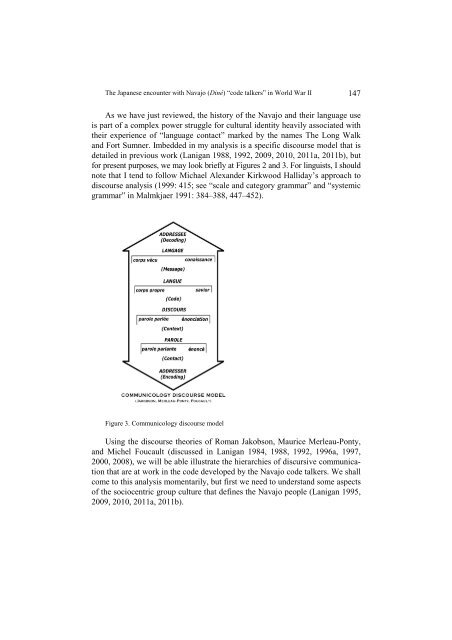s - Wyższa SzkoÅa Filologiczna we WrocÅawiu
s - Wyższa SzkoÅa Filologiczna we WrocÅawiu
s - Wyższa SzkoÅa Filologiczna we WrocÅawiu
Create successful ePaper yourself
Turn your PDF publications into a flip-book with our unique Google optimized e-Paper software.
The Japanese encounter with Navajo (Diné) “code talkers” in World War II 147<br />
As <strong>we</strong> have just revie<strong>we</strong>d, the history of the Navajo and their language use<br />
is part of a complex po<strong>we</strong>r struggle for cultural identity heavily associated with<br />
their experience of “language contact” marked by the names The Long Walk<br />
and Fort Sumner. Imbedded in my analysis is a specific discourse model that is<br />
detailed in previous work (Lanigan 1988, 1992, 2009, 2010, 2011a, 2011b), but<br />
for present purposes, <strong>we</strong> may look briefly at Figures 2 and 3. For linguists, I should<br />
note that I tend to follow Michael Alexander Kirkwood Halliday’s approach to<br />
discourse analysis (1999: 415; see “scale and category grammar” and “systemic<br />
grammar” in Malmkjaer 1991: 384–388, 447–452).<br />
Figure 3. Communicology discourse model<br />
Using the discourse theories of Roman Jakobson, Maurice Merleau-Ponty,<br />
and Michel Foucault (discussed in Lanigan 1984, 1988, 1992, 1996a, 1997,<br />
2000, 2008), <strong>we</strong> will be able illustrate the hierarchies of discursive communication<br />
that are at work in the code developed by the Navajo code talkers. We shall<br />
come to this analysis momentarily, but first <strong>we</strong> need to understand some aspects<br />
of the sociocentric group culture that defines the Navajo people (Lanigan 1995,<br />
2009, 2010, 2011a, 2011b).
















